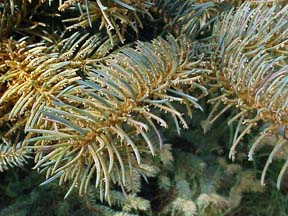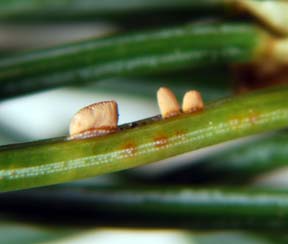Spruce needle rust disease
Editor’s note: This article is from the archives of the MSU Crop Advisory Team Alerts. Check the label of any pesticide referenced to ensure your use is included.
Rust fungi represent some of the most advanced fungal species known. Because rusts are complex diseases they can be described in many different ways. You can categorize them by their life cycles, their spore colors, their primary or alternate hosts, or the types of symptoms they cause. Using both symptoms and the conifer host is probably your best bet in identifying the rust diseases of Christmas trees in Michigan. Basically, there are two types of rusts on Michigan Christmas trees; those that cause diseases of stems and twigs and those that cause diseases of needles. An example of needle rust is beginning to show up on spruce trees near water.
Spruce needle rust overwinters on Labrador tea and leather leaf and spores from these alternate hosts have moved to the spruce trees via wind and rain events and are now infecting spruce trees. In July and August, yellow current-year needles with whitish blisters filled with yellow spores will appear on Colorado blue, black and white spruce. Shedding of infected needles will follow these infection episodes. The alternate hosts, Labrador tea leather leaf are members of the Heath family and are found in bogs and damp thickets. Care should be taken to plant spruce away from wetlands especially the rust susceptible Colorado blue, black and white spruce. Norway spruce is more resistant. Scouting for alternate hosts, roguing infected branches and trees and planting resistant stock can reduce the impact of many of these rust diseases.

Spruce needle rust.

Closeup of spruce needle rust blister.
Dr. Fulbright's work is funded in part by MSU's AgBioResearch.



 Print
Print Email
Email


